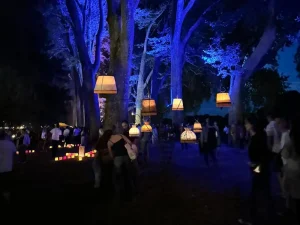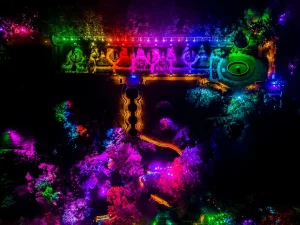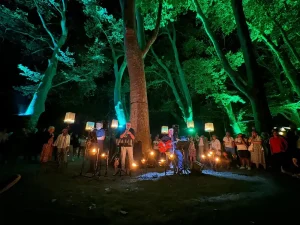Landscape lighting is the art of illuminating your outdoor spaces. It not only enhances beauty but also adds functionality and safety. But if you are just starting, you might ask: How to design landscape lighting? However, the good news is that you don’t need to be an artist.
With a basic guide, a few tools, and a bit of creativity, you can turn your landscape into a glowing masterpiece. Don’t worry if you’ve never touched a light fixture before. This guide will help you to light up your landscape in a few easy steps. So let’s get started!

Step-by-Step Guide on Designing Landscape Lighting
Designing landscape lighting might sound tricky. However, with basic skills and creative ideas, it becomes pretty easy. Hence, to make things easier, I will break it down into a few simple steps that anyone can follow. So, let’s jump right in!
Step 1: Understand Your Space
Understanding your space is the foundation of good lighting design. Once you know your yard’s strength, dark spots, and needs, it becomes easy to plan where to place each light. For this purpose, take a slow walk around your yard in the day and again at night. Each time, take note of what feels dark and which areas you use the most.
After that, evaluate which areas need to be lit for safety. Also, explore the dark, hidden places that need to be bright. You should also notice your existing light sources. Perhaps you already have a porch light or a nearby streetlight. These lights can guide your lighting plan, ensuring you don’t overlight certain areas.
Step 2: Sketch a Simple Lighting Plan
Now that you understand your space, it’s time to make a basic lighting sketch. This step is not about getting everything perfect. Instead, it helps you visualize the overall look and prevent misplacing lights. However, don’t worry; you don’t need to be an artist to make sketches. Even a rough piece of paper will help you organize things.
So start by drawing a simple layout of your yard. Include the main features, such as pathways, patios, fences, gates, sitting areas, and walls. Once your sketch is ready, mark the places you want to light. These areas may include walkways, entryways, doorsteps, trees, and dark corners. You can also add other places you find essential to light.
Step 3: Know the Different Types of Outdoor Lighting
The next step is to understand the various types of outdoor lighting. Remember, you cannot install the same kind of light in all places. Each type serves different purposes, such as some are for safety, while some enhance beauty. So, their basic know-how can help you choose the right light for each part of your landscape. Here is a list of some standard outdoor lighting you must know:
- Path Lights: These are small lights that line walkways and garden paths.
- Spotlights: Spotlights produce narrow and focused beams of light.
- Floodlights: These lights give a broad and intense beam of light.
- Sconces: These lights are mounted on walls, patios, and entryways.
Step 4: Choose the Right Bulbs and Fixtures

Now that you know different types of lights, it comes to picking the correct bulb and fixture. There are several types of bulbs available. The common ones include LED bulbs, Incandescent, halogen bulbs, and solar-powered bulbs. You can choose the one that suits your desires. However, light manufacturers recommend using LED bulbs due to their energy efficiency.
You should also decide on the right brightness (lumen). For a warm and cozy environment, opt for a low-lumen bulb. However, for visibility and safety, high-lumen bulbs are best. Lastly, choose a durable fixture for outdoor lighting. Fixtures should be strong enough to withstand the harsh environmental conditions.
Step 5: Decide on the Power Source
After you pick up the bulbs and fixtures, the next step is to determine how you will power your lights. There are three primary power sources: solar, low-voltage, and line voltage. Solar lights are easiest to install and don’t need wires. The lights absorb the sun’s energy and turn on automatically at night. However, low-voltage lighting systems are both safe and energy-efficient.
This system utilizes a transformer to reduce the 120V household current to 12V. On the other hand, line-voltage lighting uses the same power as that found inside your home. These lights are very bright, and installing them requires the services of a licensed electrician. Additionally, this power source is more energy-consuming. Therefore, it can result in an overall high cost of landscape lighting.
Step 6: Install Lights Thoughtfully
The second-to-last step is finally installing the lights you have decided on. So go back to the sketch you made earlier and use it as a map. Now, start placing the lights where you planned. If you have changed your mind, don’t worry! This step is flexible. You can change the installation position at any time.
Also, consider the angle and shadows of the lights. For the path, lights should be low and directed downward. For spotlights, avoid shining light directly into the windows. However, for soft and natural looks, use indirect light. Lastly, keep safety in mind. Ensure cords, wires, and fixtures are not tripping hazards.
Step 7: Test and Adjust
Your lights are installed! But you are not quite done yet. Now, it comes to the final and most crucial step: testing your lighting setup at night. As soon as the sun sets, turn on the lights and take a walk around your yard. Examine the lights from various angles. Also, check if any area is too dark or bright.
If there’s room for adjustment, go ahead. For example, if the light is hitting the wrong spot, reposition the fixture. Moreover, if the lights are creating a strange shadow, move the lights slightly. Lastly, check for safety and functions. Ensure all fixtures and wires are securely in place. For a solar setup, ensure that the lights are receiving direct sunlight.
Common Mistakes to Avoid When Designing Landscape Lighting
Even with the best intentions, it is easy to make a few missteps when lighting a landscape. The chances of mistakes are enhanced when you are doing it the first time. However, those mistakes can be avoided once you know what to look out for.

- The first and most significant mistake is using too many lights in your yard. It seems that more lights will look better, but actually, they make your space feel harsh and overwhelming.
- The second is poor light placement. Putting light in the wrong spot can cause glare. Therefore, always consider how light spreads and how it will be utilized.
- Ignoring light direction and angles is another big mistake. However, small angle changes can significantly enhance the effect. For example, always aim the spotlight upward at trees.
- Mixing the wrong light color can also make your yard look messy. Not all white lights are the same. Some are warm, and some are cool. So, try to maintain a consistent tone.
- Lastly, do not forget about the power load. If you are using low-voltage lighting, make sure the transformer is not overloaded. Also, check the wattage of your system and spread the load evenly.
Conclusion
Designing landscape lighting might seem tricky. However, with a few wise steps and a little creativity, you can turn your outdoor space into a glowing one. In this article, I have outlined some simple steps to enhance your landscape look. However, from understanding your space to testing lights, each step has equal importance. These steps help you install lights in an organized way. Moreover, avoid common mistakes like mixing light colors and using too many lights.
